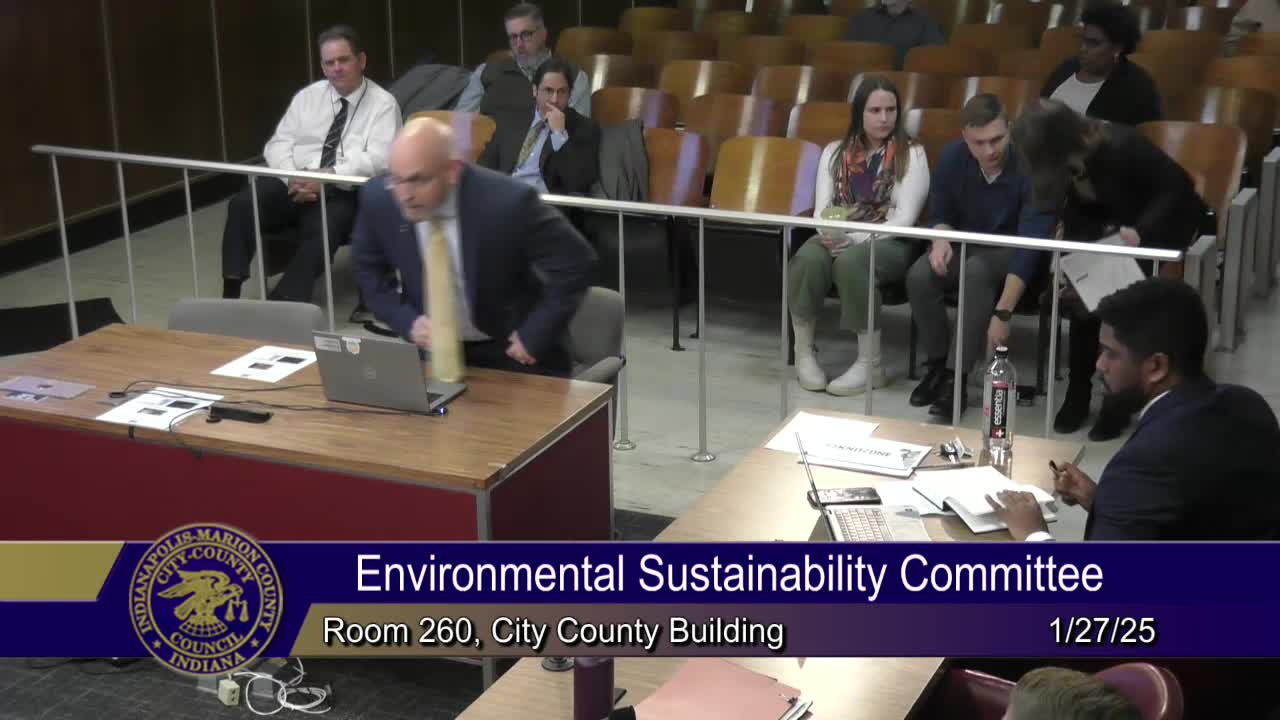IDEM forecasters explain Smog Watch, monitoring network and how air-quality action days are declared
January 27, 2025 | Indianapolis City, Marion County, Indiana
This article was created by AI summarizing key points discussed. AI makes mistakes, so for full details and context, please refer to the video of the full meeting. Please report any errors so we can fix them. Report an error »

John Welch, an air quality forecaster with the Indiana Department of Environmental Management (IDEM), briefed the Indianapolis City-County Council’s Environmental Sustainability Committee on the state’s Smog Watch forecasting system, monitoring network and the process for declaring air-quality action days.
Welch said IDEM issues daily forecasts for PM2.5 year-round and for ozone from March 1 through Oct. 31. He described a collaborative decision process with the city: IDEM provides technical forecasts and the city of Indianapolis concurs before NoZone action days are formally issued. “We do not pull the trigger essentially on an ozone action day or an ozone action day until we get concurrence from the city,” Welch said.
The Nut Graf: IDEM’s forecasting combines monitoring data, weather models and air-quality models to predict whether ozone or PM2.5 will exceed health-based standards. The agency maintains a network of continuous monitors and deploys filter-based samplers where required by EPA siting criteria. Welch described the practical steps forecasters take — examining yesterday’s measurements, weather patterns and model output — and then elevating a recommendation to city partners for public messaging and press releases.
Welch described how different pollution sources contribute to ozone and PM2.5: transportation, power plants and biogenic emissions for ozone formation; direct particle sources such as combustion, construction, brake and tire dust; and secondary formation for particulates. He also reviewed why regional and international events — for example, Canadian wildfire smoke or long-range dust events — can drive spikes in PM2.5 readings statewide.
On monitoring, Welch said the state runs continuous monitors that upload data to IDEM’s public dashboard and that some samples are collected on filters and sent to labs for analysis. Monitors are sited using EPA criteria; IDEM can deploy additional monitors and has used targeted monitoring in neighborhoods when specific concerns arise.
Committee members asked about community-level placement of monitors and about media and partner amplification of action-day information. Welch said monitors follow EPA siting guidance and that IDEM’s new mobile-friendly website and coordination with the National Weather Service and local broadcasters enhance reach. He encouraged residents to use the state’s monitoring website to view neighborhood-level AQI readings and to sign up for alerts.
Ending: Welch said the agency will continue daily forecasting during the ozone season, will coordinate early with city partners to allow the city to prepare operational changes and public messaging, and noted that recent summers have shown the utility of rapid public outreach during smoke events.
Welch said IDEM issues daily forecasts for PM2.5 year-round and for ozone from March 1 through Oct. 31. He described a collaborative decision process with the city: IDEM provides technical forecasts and the city of Indianapolis concurs before NoZone action days are formally issued. “We do not pull the trigger essentially on an ozone action day or an ozone action day until we get concurrence from the city,” Welch said.
The Nut Graf: IDEM’s forecasting combines monitoring data, weather models and air-quality models to predict whether ozone or PM2.5 will exceed health-based standards. The agency maintains a network of continuous monitors and deploys filter-based samplers where required by EPA siting criteria. Welch described the practical steps forecasters take — examining yesterday’s measurements, weather patterns and model output — and then elevating a recommendation to city partners for public messaging and press releases.
Welch described how different pollution sources contribute to ozone and PM2.5: transportation, power plants and biogenic emissions for ozone formation; direct particle sources such as combustion, construction, brake and tire dust; and secondary formation for particulates. He also reviewed why regional and international events — for example, Canadian wildfire smoke or long-range dust events — can drive spikes in PM2.5 readings statewide.
On monitoring, Welch said the state runs continuous monitors that upload data to IDEM’s public dashboard and that some samples are collected on filters and sent to labs for analysis. Monitors are sited using EPA criteria; IDEM can deploy additional monitors and has used targeted monitoring in neighborhoods when specific concerns arise.
Committee members asked about community-level placement of monitors and about media and partner amplification of action-day information. Welch said monitors follow EPA siting guidance and that IDEM’s new mobile-friendly website and coordination with the National Weather Service and local broadcasters enhance reach. He encouraged residents to use the state’s monitoring website to view neighborhood-level AQI readings and to sign up for alerts.
Ending: Welch said the agency will continue daily forecasting during the ozone season, will coordinate early with city partners to allow the city to prepare operational changes and public messaging, and noted that recent summers have shown the utility of rapid public outreach during smoke events.
View full meeting
This article is based on a recent meeting—watch the full video and explore the complete transcript for deeper insights into the discussion.
View full meeting
